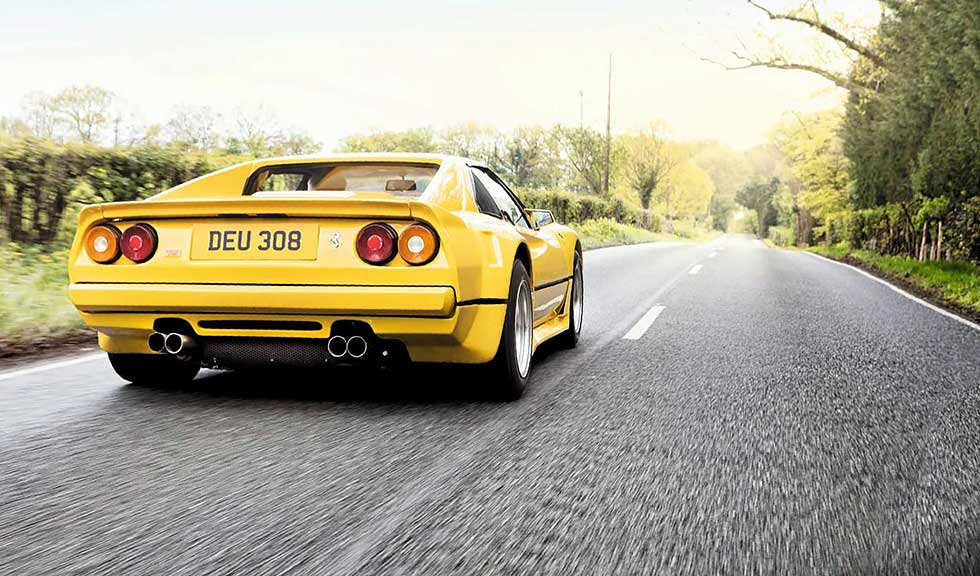
Careless torque? Holding on in the Ferrari-baiting Koenig 308 GTSi Bi-Turbo. It may look ludicrous, but the Koenig 308GTSi Bi-Turbo is deadly serious – the creation of a German racing driver who thought Ferraris has gone soft. We drive it. Words Sam Dawson. Photography Neil Fraser.
Enzo’s Wurst Nightmare Did the Koenig Specials 308 GTSi teach Ferrari a lesson?
I don’t think I’ve ever felt so self-conscious. This bright yellow Ferrari’s barely silenced exhaust has just set of its third car alarm of the day, I keep having to stop on these narrow Kentish lanes so oncoming motorists, mouths lolling in disbelief, can squeeze past its near-six-foot girth. And now I’m approaching a primary school playground at lunchtime.

An army of 10-year-olds strain over the fence for a better look. They know it’s a Ferrari – even non-petrol-heads recognise that badge – but in some ways it’s sad that they’re too young to have read Eighties car magazines. Then they’d have known it was a Koenig Specials 308GTSi Bi-Turbo, one of the fastest cars in the world.
Their teachers clearly weren’t readers either. Their eyes roll as they usher the kids away from the road. They don’t understand this car’s importance. No doubt they’ve clocked the bodykit, wider wheels and – unavoidably – the headache-inducing exhaust, and concluded it’s the work of the kind of Max Power devotee they remember trying to avoid in nightclubs in the Nineties, who’s made a few quid and likes showing of. At least it doesn’t sport the optional £400 high-rise rear wing.
It’s a pity the idea of car modification became so tarnished by adolescents wielding pop-riveters, because the aims behind Willy Koenig’s Ferrari tuning operation were as noble as they were bold. German publishing magnate Koenig campaigned Ferraris at the time when the 250GT SWB he used to win the 1962 Deutsche Bergmeisterschaft was merely a racing car with numberplates. As the Sixties gave way to the Seventies, Ferrari offered its first mid-engined road cars to the public, and in 1974 Koenig became one of the first customers to take delivery of a 365GT4 Berlinetta Boxer. However, unlike everyone else at the time, he was underwhelmed. He’d expected a road-going 312P sports-racer. Koenig’s racing-inspired modification of his own BB led to interest from other owners, prompting him to sell the publishing firm and set up his own commercial tuning business in 1977.
Enlisting the services of turbocharging engineer Frans Albert and aerodynamicist Vittorio Strosek, Koenig’s company was dedicated to ‘making Ferraris proper sports cars again.’ Afronted, Enzo Ferrari responded by threatening Koenig with legal action unless he removed the Ferrari badges from his Specials. In 1983, Koenig would respond by demonstrating the true potential of Ferrari’s 308, making it faster than a standard 512BB.
It’s one of those 308s I’m driving today. Back in January 1983 the engine tuning parts alone, including the specially-fabricated valve-actuated wastegate, cost £3625, a figure that would’ve bought you a brand new Ford Fiesta. Mahle pistons with a 7.2:1 compression ratio, forged camshafts, revised timing and a Rajay 375E turbocharger running at 0.8 bar took the Ferrari’s 205bhp V8 to an incredible 400bhp. Countach territory, in other words. But if it’s only got one turbocharger, why are there ‘Bi-Turbo’ badges all over it? Admittedly these were added by a supplying dealer, but according to Willy’s grandson Oliver Koenig, they might have been applied to distinguish it from the firm’s ‘Twin Turbo’ 512BBi conversion.

It indicates some rather elegant engineering courtesy of Frans Albert. ‘There were all kinds of thoughts as to how to optimise the power of the 308,’ says Oliver. ‘We started with normally-aspirated tuning – modified camshafts and exhaust systems – then offered a supercharger, then the turbocharged engine.’ The turbocharger had two bypass valves, and drew exhaust gases through two inlets, one from each bank of cylinders.
In the Eighties, even on V-formation engines, it was standard practice to pressurise a turbocharger from just one bank of cylinders. The Bristol Brigand’s Rotomaster unit for example scavenged its gases from the left-hand bank of its Chrysler V8. Even the then-new Maserati Biturbo and Koenig’s own Berlinetta Boxer-based creation had each turbocharger assigned to half the engine. By feeding a single turbocharger through twin entry points attached to both sides of the engine, it spools up faster, cutting throttle lag dramatically.
The result, surprisingly, is user-friendly. Get over the way that Roman and Germanic forces seem to be clashing in the engine bay with bloodlusting battle cries, and the Koenig’s lengthened gearing and increased torque turns out to have made the car more tractable. Usually, getting the best out of a 308 involves wringing out each gear all the way round the dial, but as I accelerate in third and reach 2750rpm, the outpouring of smooth torque feels more like the effortless surge of an engine with at least twice the capacity, rather than the rocket-launcher kick you get in a 288GTO. This makes its 400bhp smoother and more controllable – any speed from amble to Autobahn can be accessed via third without the car protesting.
Work those gears as you might in a standard 308, however, and provided your eardrums can withstand a high-intensity pounding worthy of a Neal Peart drum solo, you unlock Le Mans-style power and acceleration. Acceleration billows in the midrange, the car surging onwards to a claimed 190mph that it feels entirely capable of reaching.
But it’s not just a simple turbo installation and a bodykit. Whereas Janspeed in the UK, and Ameritech and BAE in the US experimented with discreet traditional boosting setups – the latter two dumping Ferrari’s traditional Weber carburettors for a Carter four-barrel – the Koenig is a complete re-engineering.
That Strosek-reworked bodywork, for example, is a masterful balance of lowered drag and strategically-added downforce, although it’s ruined if you remove the colour-coded glassfibre roof panel. The extended rear deck aids the grip of the massive rear 26/61 ZR15 Michelin TB15 tyres, while the nose sports a rounder profile than usual, channelling air into the expanded radiator grille while smoothing it over the front thanks to deleted extractor vents. Widened wings linked with skirts disguise not only wider wheels – those tyre measurements in centimeters betray them as tarmac-spec competition tyres shared with the Michelotto 308 Group 4 rally cars – but also stiffened suspension that sits the car two inches lower than usual, larger brakes and bespoke Koni dampers, a package Koenig charged £600 per corner for in 1983.

This specification would have sounded rather familiar if you followed rallying in the early Eighties, and suggests Koenig was scratching an itch with this car that Ferrari was ignoring. Ferrari only had itself to blame – it was assumed Maranello would put its wide-arched competition-ready 308GTB/4 into production following mechanical testing at Fiorano in 1976 and a Pininfarina aerodynamic study in 1977 which eventually became the 288GTO, but instead it was left to Michelotto of Padua to convert a handful of cars for rallying. ‘Willy was always inspired by racing, and the serial version of the 308 was just so limited, but had so much potential,’ says Oliver. ‘No super-sporting range-topping version of the 308 was available no matter how much you spent at Ferrari.’
Oliver is careful not to single Ferrari out for criticism, although he does admit Koenig endured a difficult relationship with them. ‘Tuners in the Eighties taught manufacturers a lot of lessons. But Willy’s main thought was always to improve the handling and performance of the car. The whole show-car idea was always secondary to him and the wide-body kits for things like Mercedes SLs and Jaguar XJ-Ss came later. The body parts Strosek created were to improve aerodynamics at high speed, not for looks.’ The modifications do, however, affect the handling. With such wide tyres – especially the front 18/60 ZR15s – the roadholding has been improved at the expense of fine feedback. Those expecting the 308 to be a race-bred supercar might have been disappointed by its straight-line performance, but it cornered beautifully, with communicative steering and a delicate, adjustable mid-bend poise. When new, the cars it seemed to be compared to most often were the Lotus Esprit and Porsche 911.
In the Koenig the steering is very heavy, as befits the wheel’s thickened rim. The oil-tanker turning circle and useless door mirrors, which stand narrower than the car’s flanks, add to a sense of low-speed unwieldiness akin to a Testarossa. Get it up to B-road speeds and you have to stay alert – on these defiantly bumpy roads, those wide front wheels tramline down every rut they can find, and require a hefty tug of the wheel to bring them back.
But as the turbocharged torque swells, I soon become grateful for all the extra stability. Lovely though the standard 308 is, it can feel under-tyred at the rear, creating a slightly nervous, knife-edged sensation at high speed. This has been cured by the Koenig’s massive track, lending it the reassuring feeling of a Porsche 930 Turbo or Lamborghini Countach S, its tyres melted to the tarmac ahead of an assault on the other side of 150mph.
And yet funnily enough, the car the Koenig reminds me of most is something Ferrari really won’t thank me for – the De Tomaso Pantera GT5. It’s the way the Bi-Turbo thunders along on a tidal bore of torque, with me feeling as though I’m sitting down below the axle-lines of a set of fat racing-style semi-slick-clad wheels housed under freakish arch extensions.
The tractability and smoothness of the anti-lagged turbocharger servese up the Koenig’s 400bhp with impressive progression. A seasoned Ferrari technician once told me that high-speed cornering on a trailing throttle in a 288GTO or F40 was a dangerous business, because the switch in power delivery in those cars is so sudden, and the effect on the performance so transformative, that a mid-corner boost had the ability to rotate the car into a spin before the driver could even think about responding. You always have to wait for a straight before turning a GTO from sports car to supercar. Same goes for a Porsche 911 Turbo 930 and Ford Sierra RS500, come to think of it.
Not so in the Koenig. As with the Pantera, the firm reassurances of low-down torque and high-grip rubber are always there, ready to punch you out of a bend. When I bear in mind that the racing variants of the Pantera were originally intended by Henry Ford II to replace the GT40, and Willy Koenig had owned and raced a GT40 and a Lola T70 before buying the Ferrari BB that disappointed him, I’m beginning to see where his idea of progress came from. And yet it stands in complete opposition to Ferrari’s usual recipe for motoring ecstasy, all operatic revs and fine feedback.
Leonardo Fioravanti would no doubt be affronted by the alterations to his styling too. Even if you considered the standard car mechanically under-endowed, there’s no denying that the way its Dino curves evolved into the era of the rubber-nosed wedge as a masterful piece of work, still keeping the visual weight in the centre of the car’s lines and avoiding slab-sidedness.

Strosek’s makeover puts a huge intercooler vent at one side but not the other, in the manner of an early Toyota MR2. The spiky side-skirts make the car look like it was hastily cut out of a vacuum injection mould, and those filled-in dummy extractor vents in the rear arches just seem garish. I know it all plays an aerodynamic role, but ironically it all conspires to look like a questionable kit-car replica strategically altered here and there to stave of attention from Pininfarina’s lawyers. At least the bumblebee-style interior isn’t all the same colour as the bodywork, spared the classic German-tuner red-with-matching-red-including-the-steering-wheel scheme that has the effect of making cars look like Lego bricks.
And yet, uncannily enough, I find myself comparing it favourably with Ferrari’s own 288GTO. That Group B monster is more stylistically reined and nowhere near as loud, but thanks to its warp-speed turbo delivery its performance is actually less usable than the Koenig’s. And then you compare the raw figures: with a top speed of 190mph, acceleration to 60mph taking 4.5 seconds and the engine producing 400bhp, the Koenig is actually 10mph and 0.5 seconds faster than the GTO. But its aerodynamic addenda are made not from the Ferrari’s exotic Kevlar, just simple glassfibre. Torque, surprisingly, was never measured but I estimate it’s somewhere north of 350lb ft.
Bizarrely, the Koenig 308 GTSi Bi-Turbo is also one of the supercar world’s most unlikely bargains. It cost £60,000 new – bear in mind that the standard 308 GTSi was £23k – but the 288GTO was £73,500 and only available to approved Ferrari customers. Nowadays GTOs breach £1.5m whereas Koenig 308s don’t even make £100k.
Ferrari purists might talk about tradition and pedigree, but the irony is that their beloved GTO doesn’t actually have any. The Group B race series it was evolved to contest never materialised. The Koenig, on the other hand, was the brainchild of a racing driver and brought to the road work comparable to that of Michelotto, NART, Facetti-Finotto and Hufaker – privateers who, like Koenig, took the 308 racing in series like IMSA GT and the World Endurance Championship.
Since 1993 no V8 Ferrari range has been without its hardcore road-racer. Competizione, Challenge Stradale, Scuderia, Speciale and now Pista – all are faster, louder and more aesthetically questionable than the cars they’re based on, and all followed this German upstart. You can’t help but look at the Koenig in this context and see it as a kind of new-era revolutionary. Those schoolchildren certainly did.
Finding and owning a Koenig Ferrari
‘I found it via Finnish classic car dealer Harri Asunta while looking for old Aston V8s in Greece,’ says James Anderson. ‘I did some research into Finland and discovered that classic Ferraris are a lot cheaper out there. There are no shortage of people buying new ones, but the classic network is focused on Helsinki, and the climate and roads aren’t Ferrari-friendly so they tend to get run into the ground.
‘I managed to find a 308GTS QV there for just €30k (£26k). Harri said he knew of another 308 that someone had hidden under a pile of rubbish in a barn – it turns out the owner hid it from his ex-wife during their divorce proceedings and then forgot about it! It needed restoration, but it was only €25k (£21k). I sent my trusted mechanic to have a look at it. It turns out someone had attempted to it a larger Garrett turbocharger and butchered the inner bodywork in order to get it to it. It needed a lot of restoration and it still needs a respray, but I can’t wait to start enjoying it.’
Tech and photos
TECHNICAL DATA FILE SPECIFICATIONS 1983 Koenig Specials Ferrari 308GTSi
Engine 2926cc transverse V8, sohc per bank, Bosch K-Jetronic fuel injection, Rajay 375E turbocharger
Max power 400bhp @ 8000rpm / DIN nett (metric)
Max torque 385lb ft @ 5900rpm / DIN net (metric)
Transmission Five-speed manual, rear-wheel drive
Suspension Front and rear: independent, unequal-length double wishbones, coil springs, telescopic dampers, anti-roll bar Brakes Servo-assisted discs front and rear
Steering Rack and pinion
Weight 1365kg
Performance Top speed: 190mph (est),
0-60mph: 4.5sec
Fuel consumption 15mpg
Price new £60,000
Value now £90,000
‘I feel as though I’m sitting down below the axle-lines of the fat racing-style semi-slick-clad wheels’
‘Ferrari purists talk about tradition and pedigree, but ironically the Koenig 308 has more than the 288GTO’







